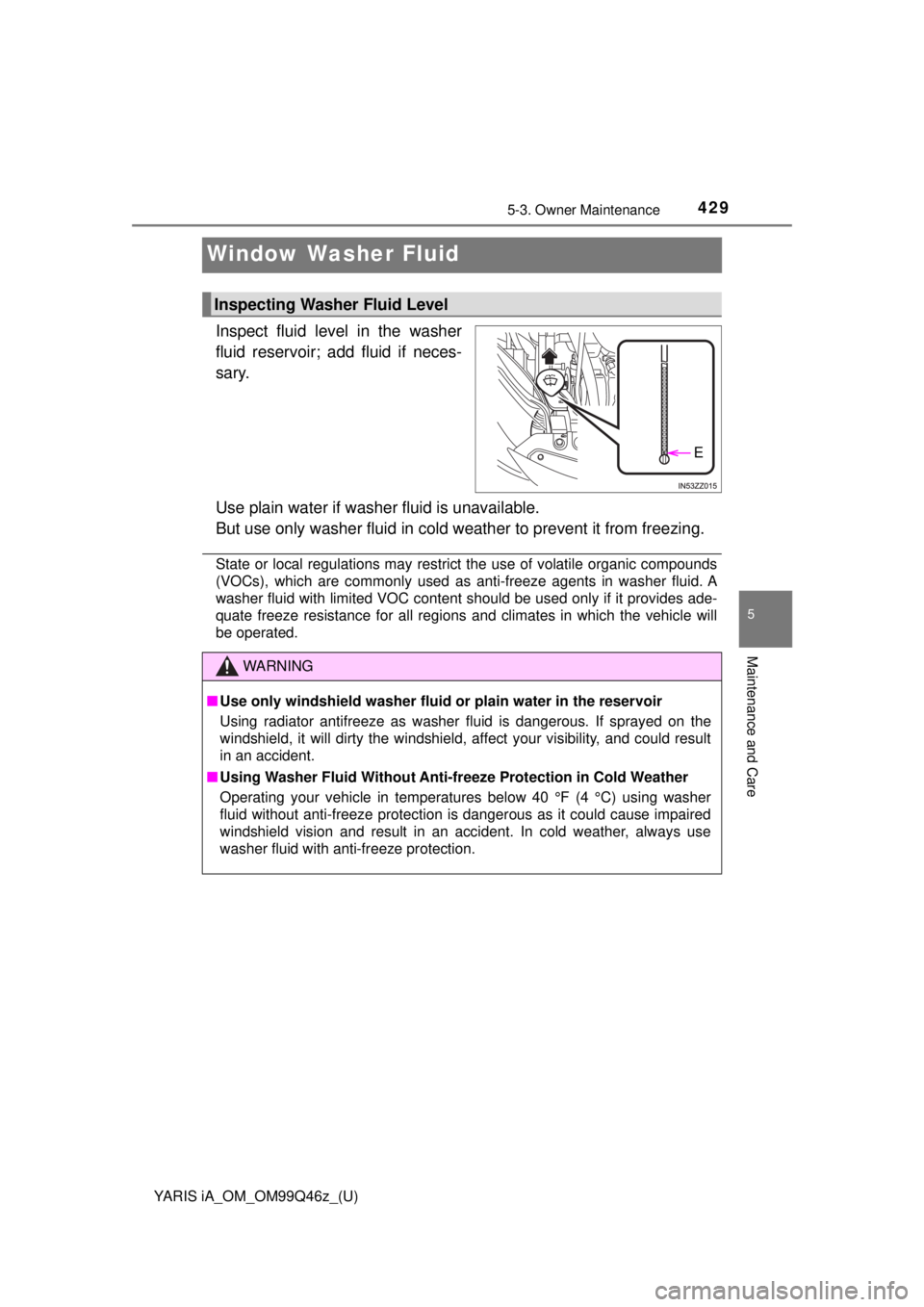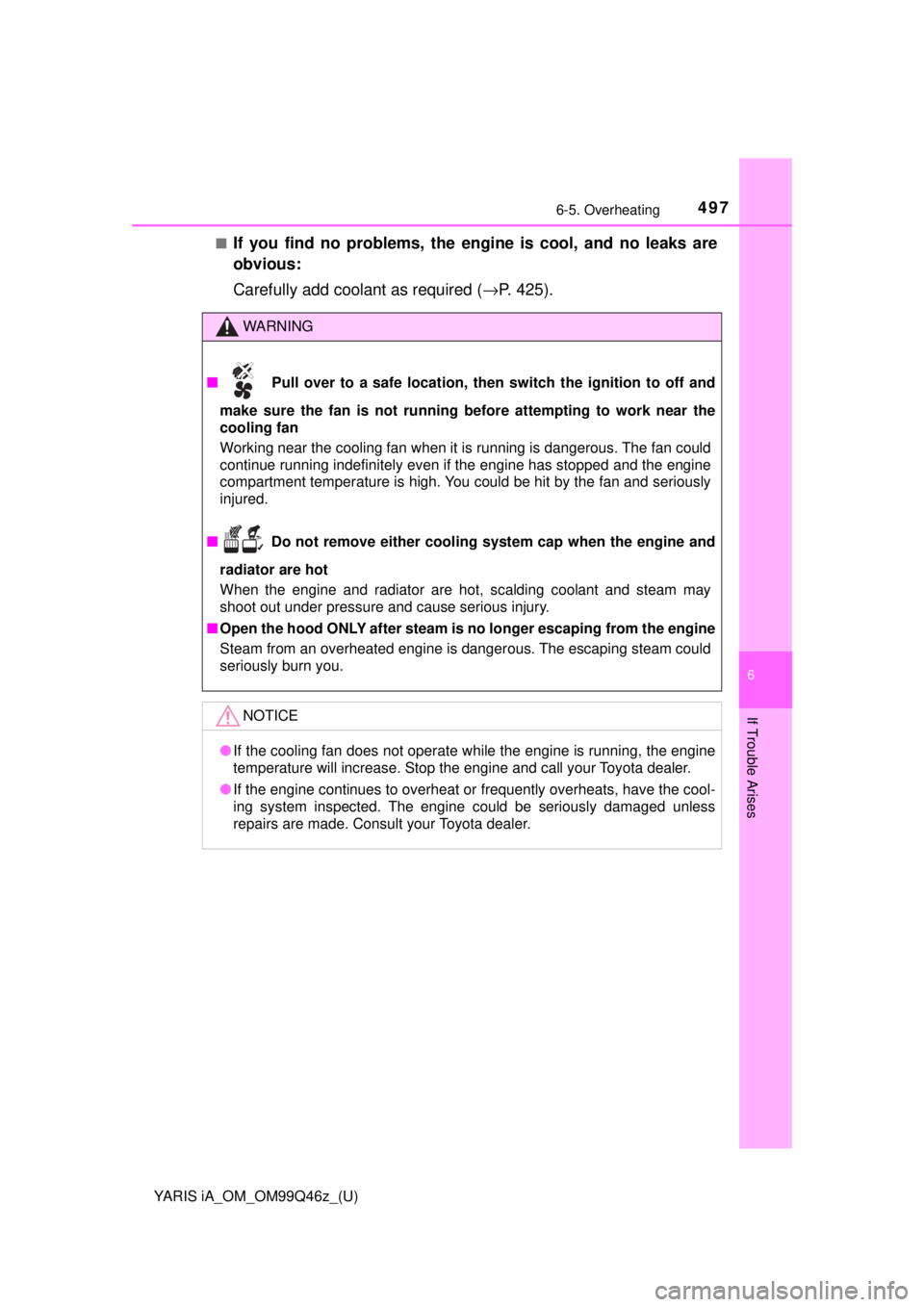2018 TOYOTA YARIS iA radiator
[x] Cancel search: radiatorPage 130 of 576

130
YARIS iA_OM_OM99Q46z_(U)
2-8. Driving Tips
Winter Driving
Carry emergency gear, including tire chains, window scraper, flares, a
small shovel, jumper cables, a nd a small bag of sand or salt.
Ask your Toyota dealer to check the following: • Have the proper ratio of antifreeze in the radiator. Refer to Engine Coolant on P. 425.
• Inspect the battery and its cables . Cold reduces battery capacity.
• Use an engine oil appropriate for the lowest ambient temperatures that the vehicle will be driven in ( →P. 422).
• Inspect the ignition sy stem for damage and loose connections.
• Use washer fluid made with antifreeze ⎯but do not use engine cool-
ant antifreeze for washer fluid ( →P. 429).
●Do not use the parking brake in freezing weather as it may freeze. Instead,
shift to 1 or R with a manual transaxle and to P with an automatic transaxle.
Block the rear wheels.
● Remove snow before driving. Snow left on the windshield is dangerous as it
could obstruct vision.
● Do not apply excessive force to a window scraper when removing ice or fro-
zen snow on the mirror glass and windshield.
● Never use warm or hot water for removing snow or ice from windows and
mirrors as it could result in the glass cracking.
● Drive slowly. Braking performance can be adversely affected if snow or ice
adheres to the brake components. If this situation occurs, drive the vehicle
slowly, releasing the accelerator pedal and lightly applying the brakes sev-
eral times until the brake performance returns to normal.
Page 182 of 576

182
YARIS iA_OM_OM99Q46z_(U)
3-4. Switches and Controls
Windshield Wipers and Washer
The ignition must be switched ON to use the wipers.
Because heavy ice and snow can jam the wiper blades, the wiper motor is
protected from motor breakdown, overheating and possible fire by a circuit
breaker. This mechanism will automatically stop operation of the blades, but
only for about 5 minutes.
If this happens, turn off the wiper switch and park off the right-of-way, and
remove the snow and ice.
After 5 minutes, turn on the switch and the blades should operate normally. If
they do not resume functioning, consult your Toyota dealer as soon as possi-
ble. Drive to the side of the road and park off the right-of-way. Wait until the
weather clears before trying to drive with the wipers inoperative.
WARNING
■Use only windshield washer fluid or plain water in the reservoir
Using radiator antifreeze as washer fluid is dangerous. If sprayed on the
windshield, it will dirty the windshield, affect your visibility, and could result
in an accident.
■ Only use windshield washer fluid mixed with anti-freeze protection in
freezing weather conditions
Using windshield washer fluid without anti-freeze protection in freezing
weather conditions is dangerous as it could freeze on the windshield and
block your vision which could cause an accident. In addition, make sure the
windshield is sufficiently warmed using the defroster before spraying the
washer fluid.
Page 425 of 576

425
YARIS iA_OM_OM99Q46z_(U)
5-3. Owner Maintenance
5
Maintenance and Care
Engine Coolant
Inspect the antifreeze protection and coolant level in the coolant res-
ervoir at least once a year—at t he beginning of the winter season—
and before traveling where temperatures may drop below freezing.
Inspect the condition and connecti ons of all cooling system and
heater hoses.
Replace any that are swollen or deteriorated.
The coolant should be at full in the
radiator and between the F and L
marks on the coolant reservoir
when the engine is cool.
Cooling fan
Cooling system cap
Coolant reservoir
If it is at or near L, add enough coolant to the coolant reservoir to pro-
vide freezing and corrosion protecti on and to bring the level to F.
Securely tighten the coolant reserv oir tank cap after adding coolant.
If the coolant reservoir is empty or new coolant is required frequently,
consult your Toyota dealer.
Changing the coolant should be done by your Toyota dealer.
Inspecting Coolant Level
1
2
3
Page 426 of 576

4265-3. Owner Maintenance
YARIS iA_OM_OM99Q46z_(U)
WARNING
■Do not use a match or live flame in the engine compartment. DO NOT
ADD COOLANT WHEN THE ENGINE IS HOT
A hot engine is dangerous. If the engine has been running, parts of the
engine compartment can become very hot. You could be burned. Carefully
inspect the engine coolant in the coolant reservoir, but do not open it.
■ Pull over to a safe location, then switch the ignition to off and
make sure the fan is not running befo re attempting to work near the
cooling fan
Working near the cooling fan when it is running is dangerous. The fan could
continue running indefinitely even if the engine has stopped and the engine
compartment temperature is high. You could be hit by the fan and seriously
injured.
■ Do not remove either cooling system cap when the engine and
radiator are hot
When the engine and radiator are hot, scalding coolant and steam may
shoot out under pressure and cause serious injury.
Page 427 of 576

YARIS iA_OM_OM99Q46z_(U)
4275-3. Owner Maintenance
5
Maintenance and Care
NOTICE
●Radiator coolant will damage paint. Rinse it off quickly if spilled.
● Use only soft (deionized) water in the coolant mixture. Water that contains
minerals will cut down on the coolant’s effectiveness.
● Do not add only water. Always add a proper coolant mixture.
● The engine has aluminum parts and must be protected by an ethylene-gly-
col-based coolant to prevent corrosion and freezing.
● DO NOT USE coolants Containing Alcohol, methanol, Borate or Silicate.
These coolants could damage the cooling system.
● DO NOT MIX alcohol or methanol with the coolant. This could damage the
cooling system.
● Do not use a solution that contains more than 60% antifreeze.
This would reduce effectiveness.
● Use of engine coolant specifically designed for the YARIS iA is required
when replacing engine coolant. Using engine coolant that is not specifi-
cally designed for this vehicle may cause serious damage to the engine
and cooling system. For questions on how to obtain this specially
designed coolant, contact your Toyota dealer.
Page 429 of 576

429
YARIS iA_OM_OM99Q46z_(U)
5-3. Owner Maintenance
5
Maintenance and Care
Window Washer Fluid
Inspect fluid level in the washer
fluid reservoir; add fluid if neces-
sary.
Use plain water if washer fluid is unavailable.
But use only washer fluid in cold weather to prevent it from freezing.
State or local regulations may restrict the use of volatile organic compounds
(VOCs), which are commonly used as anti-freeze agents in washer fluid. A
washer fluid with limited VOC content should be used only if it provides ade-
quate freeze resistance for all regions and climates in which the vehicle will
be operated.
Inspecting Washer Fluid Level
E
WARNING
■Use only windshield washer fluid or plain water in the reservoir
Using radiator antifreeze as washer fluid is dangerous. If sprayed on the
windshield, it will dirty the windshield, affect your visibility, and could result
in an accident.
■ Using Washer Fluid Without Anti-f reeze Protection in Cold Weather
Operating your vehicle in temperatures below 40 °F (4 °C) using wa\
sher
fluid without anti-freeze protection is dangerous as it could cause impaired
windshield vision and result in an accident. In cold weather, always use
washer fluid with ant i-freeze protection.
Page 496 of 576

496
YARIS iA_OM_OM99Q46z_(U)
6-5. Overheating
Overheating
If the high engine coolant temperature warning light turns on:Drive safely to the side of the road and park off the right-of-way.
Put a vehicle with an automatic tr ansaxle in park (P), a manual tran-
saxle in neutral.
Apply the parking brake.
Turn off the air conditioner.
Check whether coolant or steam is escaping from the engine com-
partment.
If steam is coming from the engine compartment
Do not go near the front of the vehicle. Stop the engine.
Wait until the steam dissipates, then open the hood and start the
engine.
If neither coolant nor steam is escaping
Open the hood and idle the engine until it cools.
Make sure the cooling fan is operating, then turn off the engine after
the temperature has decreased.
When cool, check the coolant level.
If it is low, look for coolant leaks from the radiator and hoses.
■If you find a leak or other damage , or if coolant is still leaking:
Stop the engine and call your Toyota dealer.
Cooling fan
Cooling system cap
Coolant reservoir
If the high engine coolant temperature warning light turns on,
the vehicle loses power, or you hear a loud knocking or pinging
noise, the engine is probably too hot.
1
2
3
4
5
6
7
1
2
3
Page 497 of 576

YARIS iA_OM_OM99Q46z_(U)
4976-5. Overheating
6
If Trouble Arises
■If you find no problems, the engine is cool, and no leaks are
obvious:
Carefully add coolant as required (→P. 425).
WARNING
■ Pull over to a safe location, then switch the ignition to off and
make sure the fan is not running befo re attempting to work near the
cooling fan
Working near the cooling fan when it is running is dangerous. The fan could
continue running indefinitely even if the engine has stopped and the engine
compartment temperature is high. You could be hit by the fan and seriously
injured.
■ Do not remove either cooling system cap when the engine and
radiator are hot
When the engine and radiator are hot, scalding coolant and steam may
shoot out under pressure and cause serious injury.
■ Open the hood ONLY after steam is no longer escaping from the engine
Steam from an overheated engine is dangerous. The escaping steam could
seriously burn you.
NOTICE
● If the cooling fan does not operate while the engine is running, the engine
temperature will increase. Stop the engine and call your Toyota dealer.
● If the engine continues to overheat or frequently overheats, have the cool-
ing system inspected. The engine could be seriously damaged unless
repairs are made. Consult your Toyota dealer.